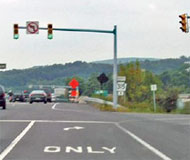Article from: www.thenewspaper.com/news/41/4172.asp
8/15/2013
Federal 1995 Study: Right Turns On Red Not Dangerous
Despite the focus on right turns with photo enforcement, NHTSA concludes right turns on red are rarely dangerous.
 Lawmakers in several states have begun to crack down on excessive shortening of yellow light times at red light camera intersections, and the photo enforcement industry has responded by shifting focus to right turn enforcement. The states of Ohio and Georgia were the first to require one extra second of yellow be added to an intersection where cameras issue tickets, effectively eliminating the profit available to cities for enforcing straight-through violations at an intersection.
Lawmakers in several states have begun to crack down on excessive shortening of yellow light times at red light camera intersections, and the photo enforcement industry has responded by shifting focus to right turn enforcement. The states of Ohio and Georgia were the first to require one extra second of yellow be added to an intersection where cameras issue tickets, effectively eliminating the profit available to cities for enforcing straight-through violations at an intersection.
Increasingly right-on-red ticketing has become the primary source of program revenue. In many cities, turning tickets account for up to 80 percent of tickets issued. So far, only a handful of states have responded to this development, with Tennessee being the only jurisdiction to ban red light cameras from ticketing right turn violations (view attorney general's ruling). Florida adopted a vague standard that allows right turns on red made "in a careful and prudent manner."
It has been known since for decades that heavy enforcement of right turn violations produces little benefit in terms of safety. A 1995 study by the National Highway Traffic Safety Administration confirmed the lack of danger involved in turning right on red.
The study used a decade's worth of data, from 1982 to 1992, taken from state collision databases in Illinois, Indiana, Maryland, and Missouri along with federal data from the Fatal Accident Reporting System (FARS). Only 84 out of 485,104 fatalities that occurred in that ten-year period involved turning right on red. The databases do not reveal whether the accidents happened during a legal maneuver or an illegal turn. Many of the crashes took place when a motorist turned right on a green light.
"The actual number of fatal right turn on red crashes is somewhere between zero and 84 and may be closer to zero than 84," the study found.
Of the incidents that did take place, about 44 percent involved hitting a pedestrian, 33 percent striking another car and 10 percent hitting a bicyclist. The data show that right turn crashes, when they happened, were less likely to involve serious consequences compared to other types of collision.
"Right turn on red crashes seem to involve slightly less injuries and fatalities than other crashes at signalized intersections," the report found.
Among crashes in the state files, right turn on red was involved in 0.05 percent of all collisions, and 0.06 of those involving an injury or fatality. The National Highway Traffic Safety Administration determined this number was not significant.
"In conclusion, there are a relatively small number of deaths and injuries each year caused by right turn on red crashes," the study concluded. "These represent a very small percentage of all crashes, deaths and injuries. Because the number of crashes due to right turn on red is small, the impact on traffic safety, therefore, has also been small."
A copy of the report is available in a 150k PDF file at the source link below.
Source: The Safety Impact of Right Turn on Red (National Highway Traffic Safety Administration, 2/5/1995)
Permanent Link for this item
Return to Front Page
 Lawmakers in several states have begun to crack down on excessive shortening of yellow light times at red light camera intersections, and the photo enforcement industry has responded by shifting focus to right turn enforcement. The states of Ohio and Georgia were the first to require one extra second of yellow be added to an intersection where cameras issue tickets, effectively eliminating the profit available to cities for enforcing straight-through violations at an intersection.
Lawmakers in several states have begun to crack down on excessive shortening of yellow light times at red light camera intersections, and the photo enforcement industry has responded by shifting focus to right turn enforcement. The states of Ohio and Georgia were the first to require one extra second of yellow be added to an intersection where cameras issue tickets, effectively eliminating the profit available to cities for enforcing straight-through violations at an intersection.